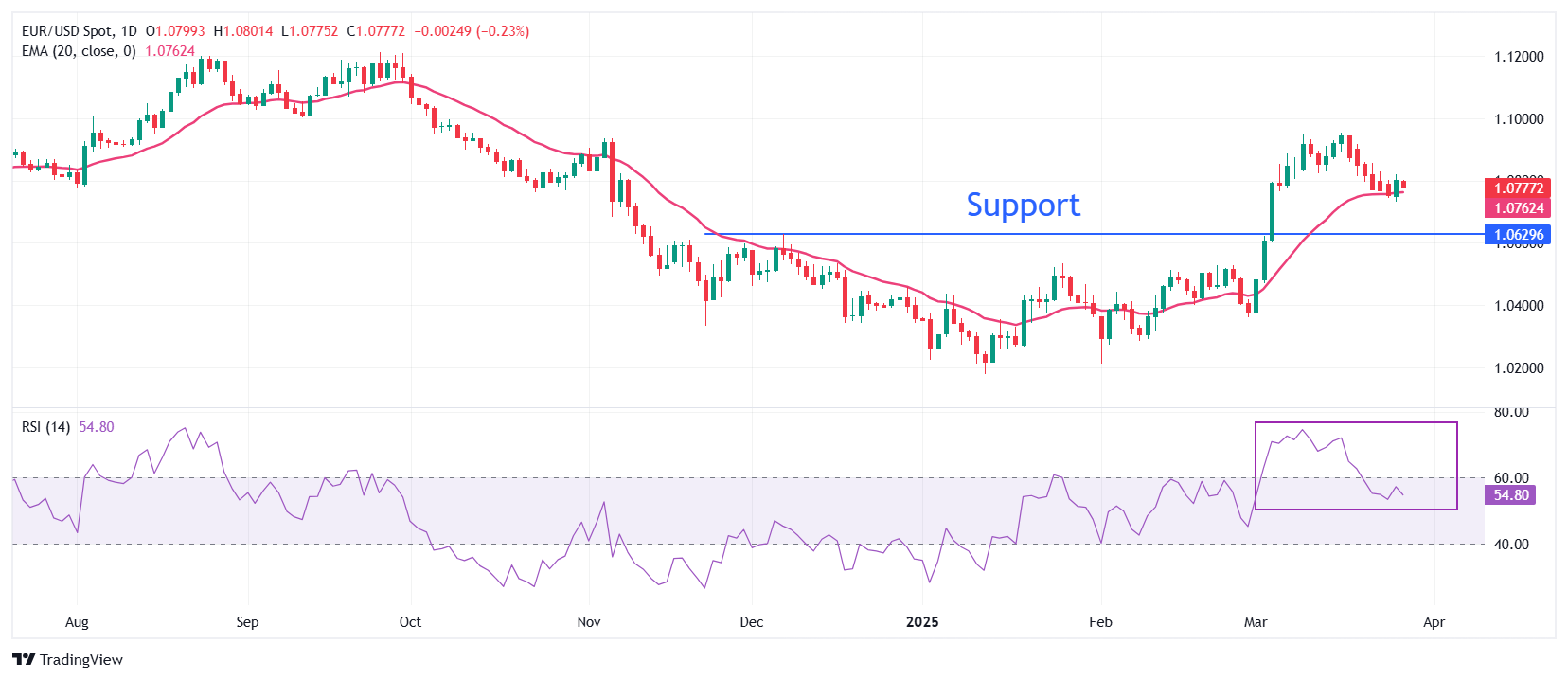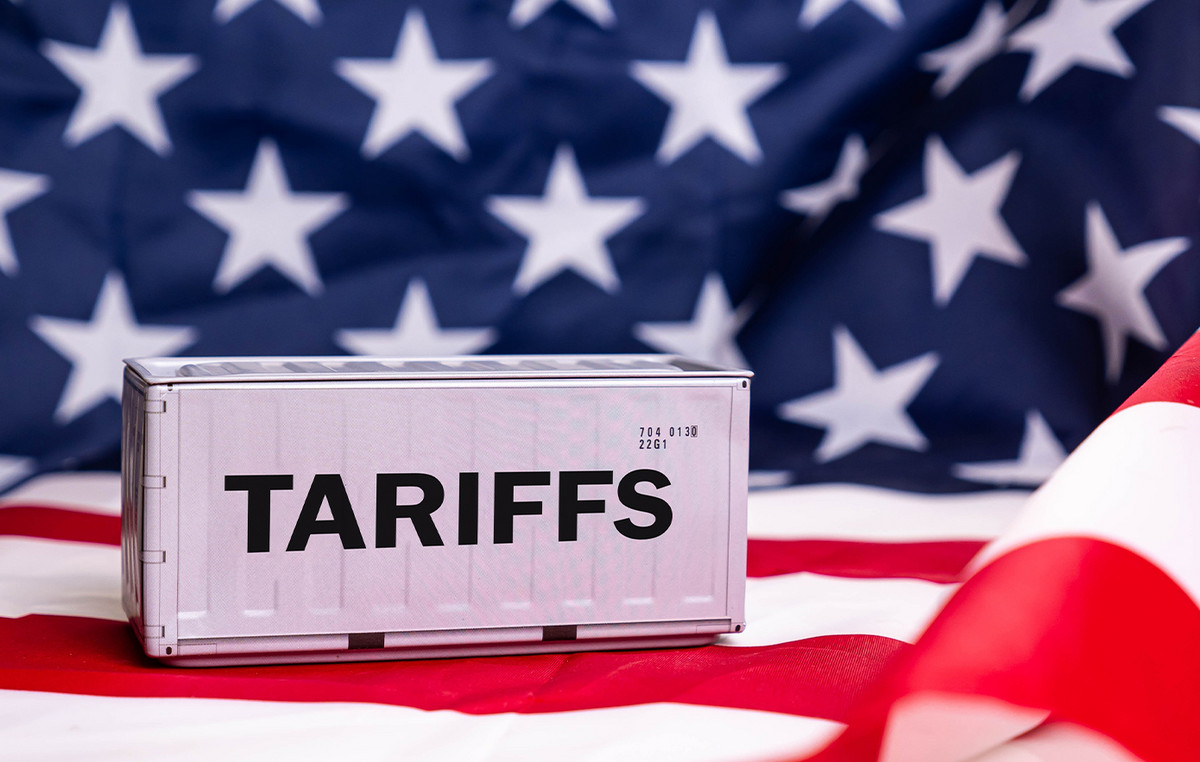- The EUR/USD faces pressure about 1,0800 while investors are cautious before US PCE inflation data for February.
- The European Commission prepares for retaliation measures against the automotive tariffs of US President Trump.
- Inflation in Spain and France grew at a moderate pace in March.
EUR/USD descends to about 1,0775 during Friday’s European negotiation hours. The main currency pair faces pressure since the president of the United States (USA), Donald Trump, is ready to announce imminent reciprocal tariffs on April 2.
The imposition of reciprocal tariffs by President Trump is expected to despite economic growth and increase inflationary pressures worldwide, including USA Trump also announced 25% tariffs on cars entering the US on Wednesday, which will come into force as of April 2. Trump’s automotive tax has resulted in global chaos in the actions of car manufacturing companies and their assistants.
Federal Reserve officials (FED) have expressed concerns about a resurgence of short -term price pressures due to Trump’s tariff agenda. “It seems inevitable that tariffs will increase short -term inflation,” said Bank Bank of Boston, Susan Collins, in an event on Thursday. Collins added that it seems more likely that not at this time that the increase in inflation is “short -term”, but warned about “potential risks” that the greatest price pressures could be persistent. On the perspective of interest rates, Collins said that keeping them at their current levels for longer “will probably be appropriate.” However, the Fed should show “active patience” and be ready to be “flexible.”
In Friday’s session, investors will focus on the US personal consumption expenditure index (PCE) for February, which will be published at 12:30 GMT. Economists expect the U.S. underlying PCE inflation, which is the Fed’s favorite inflation indicator, has grown at a faster rate of 2.7% interannual, compared to the increase of 2.6% observed in January.
The impact of underlying inflation data is expected to be limited on market speculation regarding the Fed monetary policy perspective, since the fate of the Central Bank depends largely on the consequences of Donald Trump’s economic policies.
What moves the market today: the EUR/USD descends to the possible commercial war between the US and the EU
- The EUR/USD weakens in the midst of a growing uncertainty about the euro (EUR) due to the potential risks of a commercial war between the Eurozone and the US. The European Commission (EC) plans to announce retaliation tariffs against the US for imposing a 25% tax on cars. German car manufacturers send 13% of their total car exports to the US, and a 25% tariff on cars could make their cars less competitive in the global market.
- “We regret the 25% tariffs on cars and a new set of measures that will arrive on April 2, but we are preparing for all this,” said the CE spokesman, Olof Gill, Thursday. When asked about the degree and time of retaliation measures, Gill abstained to guide on exact times, but said they will be “appropriate, robust, well calibrated and will achieve the desired impact.”
- The participants of the financial market and German leaders warned that automotive tariffs would be a situation of losing-perder for both countries. “Trump’s decision is incorrect,” said German Chancellor Olaf Scholz on Thursday and added that the US has chosen a path to the end of which “there are only losers,” since tariffs and isolation harm prosperity “for all.”
- Meanwhile, the officials of the European Central Bank (ECB) expect the Trump tariff agenda to harm the economic growth of the Eurozone and increase short -term inflationary pressures. The Vice President of the ECB, Luis de Guindos, said that the impact of tariffs on inflation will be temporary, but will be persistent on growth. “For growth, trade is extremely harmful,” said De Guindos and added that “the worst result is a vicious circle of tariffs/reprisals.” On the monetary policy guide, Guindos said, “it is very difficult to say what the ECB will do in April.”
- In the economic front, the preliminary inflation data of March of France and Spain have shown that price pressures increased at a slower pace than expected. In the 12 months until March, the consumer price index (CPI) of France (EU standard) constantly increased 0.9%, slower than estimates of 1.1%. In the same period, the Harmonized Index of consumer prices (HICP) of Spain grew at a slower pace of 2.2%, compared to the previous publication of 2.9%.
Technical Analysis: The EUR/USD maintains the 20 -day key EMA
The EUR/USD falls to about 1,0775 on Friday, but continues to maintain the 20 -day exponential (EMA) mobile average, which quotes around 1,0760.
The 14 -day relative force index (RSI) cools below 60.00, suggesting that the bullish impulse is over, but the upward inclination remains intact.
Looking down, the maximum of December 6, 1,0630 will act as the main support zone for the torque. On the contrary, the psychological level of 1.1000 will be the key barrier to the euros of the euro.
Euro Faqs
The euro is the currency of the 19 countries of the European Union that belong to the Eurozone. It is the second most negotiated currency in the world, behind the US dollar. In 2022, it represented 31 % of all foreign exchange transactions, with an average daily business volume of more than 2.2 billion dollars a day. The EUR/USD is the most negotiated currency pair in the world, with an estimate of 30 %of all transactions, followed by the EUR/JPY (4 %), the EUR/GBP (3 %) and the EUR/AU (2 %).
The European Central Bank (ECB), based in Frankfurt (Germany), is the Eurozone reserve bank. The ECB establishes interest rates and manages monetary policy. The main mandate of the ECB is to maintain price stability, which means controlling inflation or stimulating growth. Its main tool is the rise or decrease in interest rates. Relatively high interest rates (or the expectation of higher types) usually benefit the euro and vice versa. The GOVERNMENT BOOK of the ECB makes decisions about monetary policy in meetings that are held eight times a year. The decisions are made by the directors of the National Banks of the Eurozone and six permanent members, including the president of the ECB, Christine Lagarde.
Eurozone inflation data, measured by the harmonized consumer prices index (IPCA), are an important economic indicator for the euro. If inflation increases more than expected, especially if it exceeds 2% of the ECB, it forces the ECB to rise interest rates to control it again. Relatively high interest rates compared to their counterparts usually benefit the euro, since they make the region more attractive as a place for global investors to deposit their money.
Published data measure the health of the economy and can have an impact on the euro. Indicators such as GDP, manufacturing and services PMIs, employment and consumer trust surveys can influence the direction of the single currency. A strong economy is good for the euro. Not only attracts more foreign investment, but it can encourage the ECB to raise interest rates, which will directly strengthen the euro. Otherwise, if economic data is weak, the euro is likely to fall. The economic data of the four largest economies in the euro zone (Germany, France, Italy and Spain) are especially significant, since they represent 75% of the economy of the euro area.
Another important fact that is published on the euro is the commercial balance. This indicator measures the difference between what a country earns with its exports and what you spend on imports during a given period. If a country produces highly demanded export products, its currency will gain value simply by the additional demand created by foreign buyers seeking to buy those goods. Therefore, a positive net trade balance strengthens a currency and vice versa in the case of a negative balance
Source: Fx Street
I am Joshua Winder, a senior-level journalist and editor at World Stock Market. I specialize in covering news related to the stock market and economic trends. With more than 8 years of experience in this field, I have become an expert in financial reporting.








